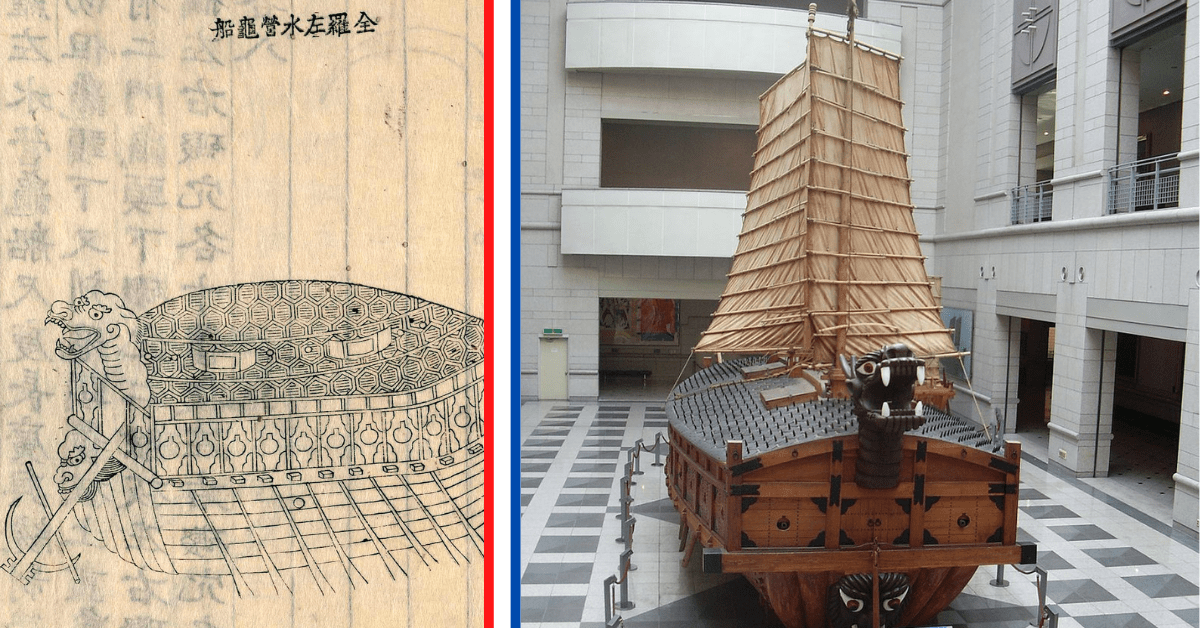Korea vs Japan in the 1590s: Admiral Yi’s Turtle Ships

Scaled-down turtle ship model in the War Memorial of Korea
SUMMARY
In Northeast Asia, North Korea’s nuclear saber-rattling and reckless rocket launches, along with communist China’s daily acts of military aggression, serve as a reminder that the region has only seen a few short stretches of uneasy peace over millennia.
Until the current era, it was usually some Chinese empire or Japanese samurai dynasty making war with its rivals, and the small country of Korea stuck in the middle. One such time was in the very last decades of the 1500s. While English pirates of the Caribbean plundered treasure-laden Spanish galleons on one side of the world, on the other side the Hermit Kingdom of Korea was in a desperate fight against Japanese invaders intent on conquering Korea on their way to attack China.
In 1587, Japan’s Imperial Regent, and all-around head samurai in charge Toyotomi Hideyoshi, began negotiating with Korean rulers for passage through their country to attack China’s Ming Dynasty. From humble peasant beginnings, Hideyoshi became a trusted retainer of the prominent lord Oda Nobunaga, who had largely achieved the almost impossible task of uniting Japan after 150 years of constant civil war among Japan’s prominent samurai clans. Upon Nobunaga’s death, Hideyoshi consolidated Japan in the 1580s, becoming the most powerful man in Japan. With a country full of idle samurai, Hideyoshi sought to put all that martial energy to use by taking on a declining Ming Dynasty in China; however, the only practical way to invade China was to land troops in nearby Korea first.
During most of its history, Korea’s default diplomatic position was to be a reluctant ally of China. When repressive Chinese regimes came along, Koreans would rebel, occasionally enjoy independence for a while, or suffer under Chinese occupation. Content with the status quo with the Ming Dynasty and knowing that an alliance with a Japanese samurai regime was a deal with the devil, Korea chose to resist the inevitable Japanese invasion.
Throughout its history, Korea had to rely on strategy and innovative military technology to prevent being overwhelmed. One innovation of the late 1500s was the Hwach'a, a wheeled, black powder-fueled multi-barrel arrow launcher capable of propelling up to 100 conventional arrows or smaller numbers of larger projectiles out to 2,000 meters. For comparison, conventional bows had a range of 50 meters, and larger, ballista-type torsion-powered single arrow launchers had ranges out to 500 meters.
At the same time, Korean Admiral Yi, Sun-Shin is credited with the development of what is probably the world’s first ironclad warship, called the geobukseon or “turtle ship.” The ships had a wooden roof covered with iron plates and hides. Dozens of iron spikes protruded from the roof to prevent enemy boarding. Sails were used for transit, but the crews rowed during battle.
Admiral Yi relied on his knowledge of the rugged and complex coastline of Korea, with some of the greatest tidal variations found anywhere in the world. In fact, during the 1950-1953 Korean War, U.S. Navy planners, with fresh experience from World War II, advised against any amphibious assault along the western Korean coast where the average rise and fall of tides is over twenty feet. Combined with the impervious turtle ships, he defeated the Japanese navy piecemeal during a series of sixteen naval battles between 1592 and 1598.
Having no more than five turtle ships at any time, Admiral Yi was always outnumbered but always victorious. At one point, he refused to act on information provided by a spy, which would have lured him to a stretch of notoriously treacherous, rocky waters, in an attempt to use his own tactics against him. He was relieved of command by a king jealous of his fame, imprisoned, and brutally tortured, however after a devastating loss of ships in battle by his successor, he was wisely reinstated. In his greatest victory, the Battle of Myeongnyang, he destroyed over 30 Japanese ships out of a fleet of 133 warships and two hundred other ships, without any Korean losses. He died of a gunshot wound on December 16th, 1598, during the final battle of the Japanese invasion. Unable to achieve naval superiority and secure their supply lines back to Japan, Hideyoshi withdrew from Korea.
Admiral Yi’s legacy draws high praise from across the world’s naval authorities and historians. British Admiral and prolific naval author George Alexander Ballard actually compared Admiral Yi to Lord Nelson of England, citing that like Nelson, he was never defeated and died fighting with victory in sight.
Even more impressive praise for Admiral Yi came from 20th-century Japanese Admiral Togo, who stunned the world in 1905 by defeating two Imperial Russian Navy fleets close to Korean waters. After his victories, Togo humbly accepted comparison to Nelson, but flatly said Admiral Yi had no superiors in naval warfare.
SHARE
